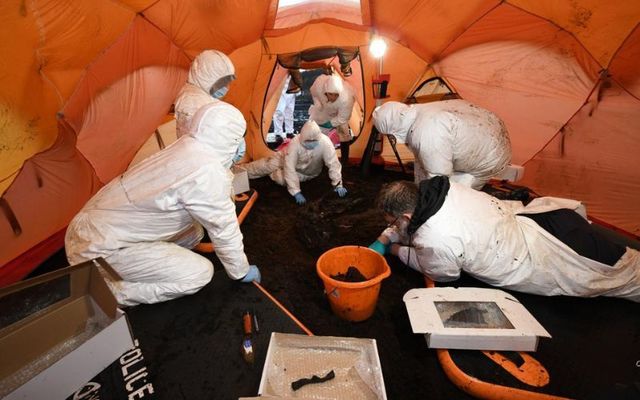Police in Northern Ireland have discovered a bog body believed to be at least 2,000 years old in County Derry.
The Archaeology Unit within the PSNI's Body Recovery Team discovered the body during excavations after members of the public reported seeing human remains on the surface of peatland in Bellaghy, County Derry, last October.
Detective Inspector Nikki Deehan said in a statement that officers were initially unsure if the remains were ancient or the result of a more recent death.
"Therefore, we proceeded to excavate the body with full forensic considerations in a sensitive and professional manner. This approach also ensures that any DNA evidence could be secured for any potential criminal investigation. Ultimately this wasn’t the case in this instance," Deehan said in a statement.
The excavations first uncovered a tibia and fibula belonging to a lower left leg and a humorous, ulna, and radius belonging to the right arm of the same individual.
Further investigation revealed more bones related to the same individual buried five meters below the surface remains, including the bones of a lower left arm, a left femur, finger bones, fingernails, and part of a breastbone.
Experts have estimated that the individual was a male between the ages of 13 and 17 at the time of death.
Little is known at present about the cause of death, but Deehan said the individual's skeleton was well-preserved and had the presence of partial skin, fingernails, toenails, and possibly a kidney.
"The well-preserved nature of the body meant radiocarbon dating could be used to ascertain the time of death," Deehan said.
"The radiocarbon dates have placed the time of death between 2,000 - 2,500 years ago, approximately 500BC.
"This is the first time radiocarbon dating has been used on a bog body in Northern Ireland, and the only one to still exist, making this a truly unique archaeological discovery for Northern Ireland."
The radiocarbon dating was carried out by 14Chrono Centre, part of Queen's University Belfast.
Dr. Alastair Ruffell, a professor in forensic geoscience at the university, said teams conducted two phases of ground-penetrating radar survey at the site. The results showed no evidence of further human remains.
"The remains were discovered at approximately one meter below the current land surface which matches the radiocarbon estimates. In addition, they were amongst a cluster of fossil tree remains suggesting that the body may have died or been buried in a copse or stand of trees, or washed in," Ruffell said.




Comments